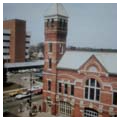You are here
Ann Arbor Hands-On Museum (Ann Arbor Central Fire Station)
In the early 1880s, when the citizens of Ann Arbor decided to replace their wood-frame firehouse with a new fireproof building, consciously or subconsciously they were seeking an expression of civic pride. In May 1882, the city aldermen selected the plans of William Scott and Company of Detroit and the following year completed the Richardsonian Romanesque building that faces 219 E. Huron Street. It is boldly polychrome with brick walls and corbeling and stone trim. Decorative gabled wall dormers project from the truncated hipped roof and round- and segmental-arched windows are grouped in threes above the three pedimented engine portals. An Italianate hose and bell tower rises confidently at the southeast corner of the former fire station, as if to signal the city's attainment of civic maturity. Today interactive science and technology exhibits of the hands-on museum occupy the former fire station and the brightly colored thirty-one-thousand-square-foot addition, which also holds classrooms, offices, galleries, and a shop.
Writing Credits
If SAH Archipedia has been useful to you, please consider supporting it.
SAH Archipedia tells the story of the United States through its buildings, landscapes, and cities. This freely available resource empowers the public with authoritative knowledge that deepens their understanding and appreciation of the built environment. But the Society of Architectural Historians, which created SAH Archipedia with University of Virginia Press, needs your support to maintain the high-caliber research, writing, photography, cartography, editing, design, and programming that make SAH Archipedia a trusted online resource available to all who value the history of place, heritage tourism, and learning.


















